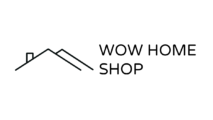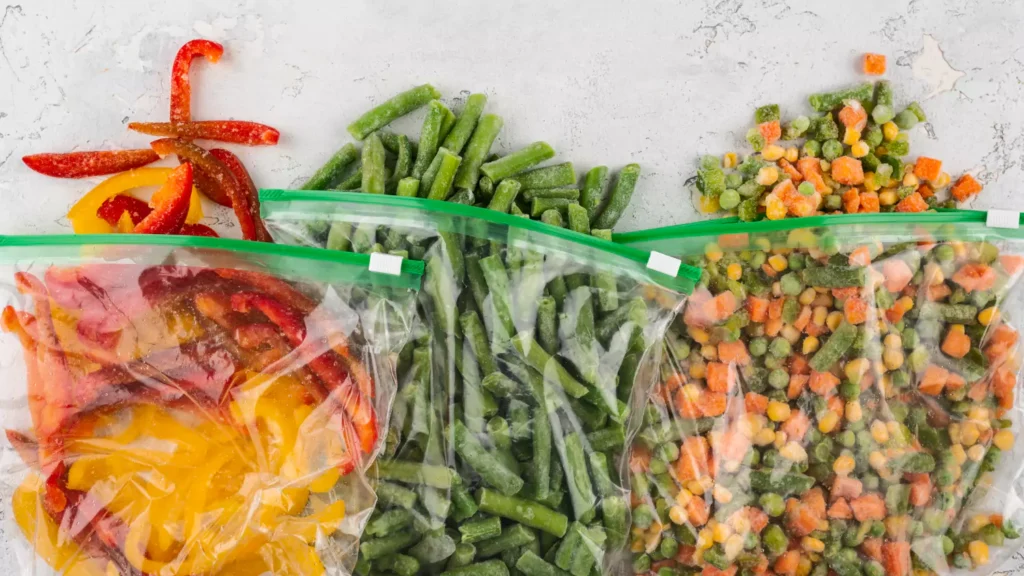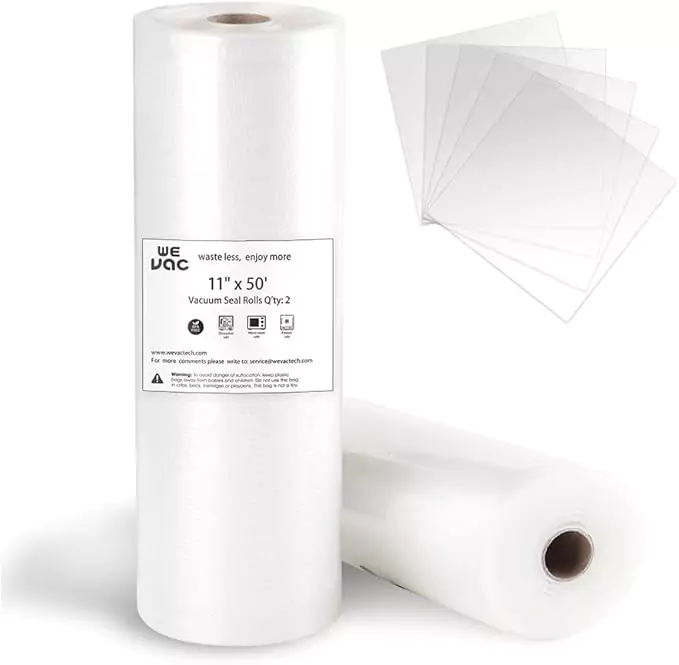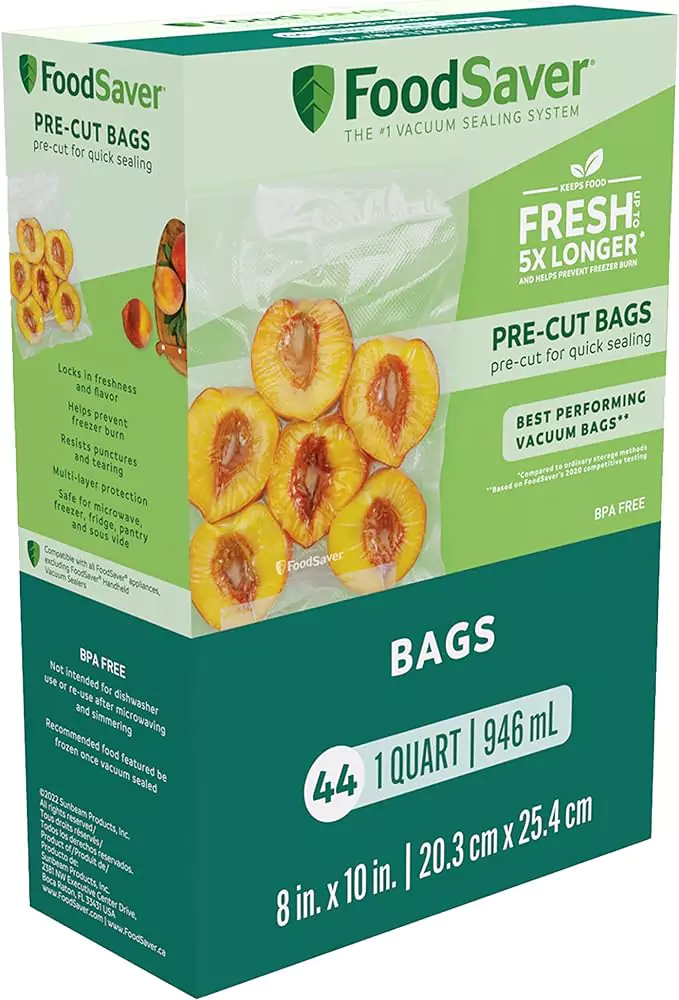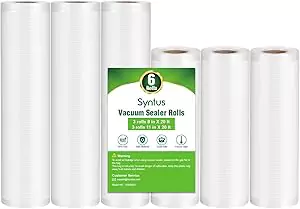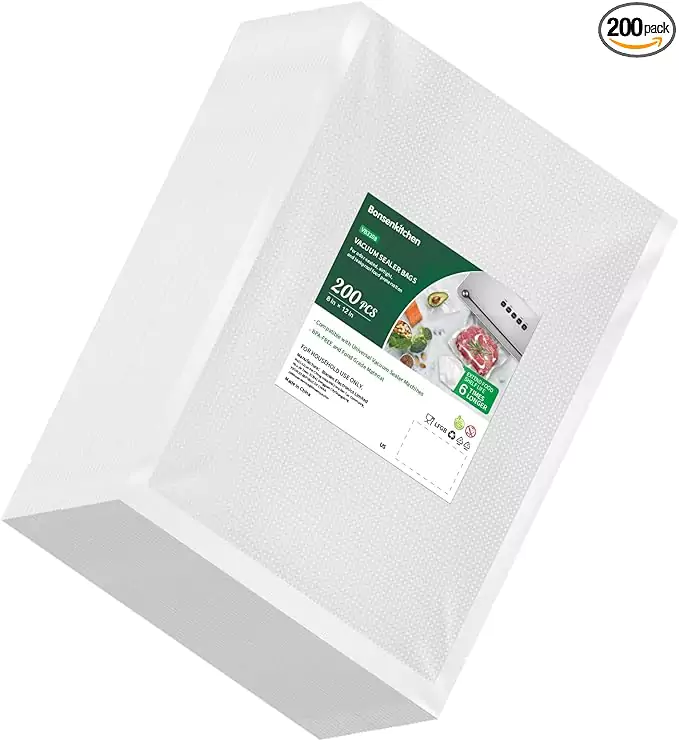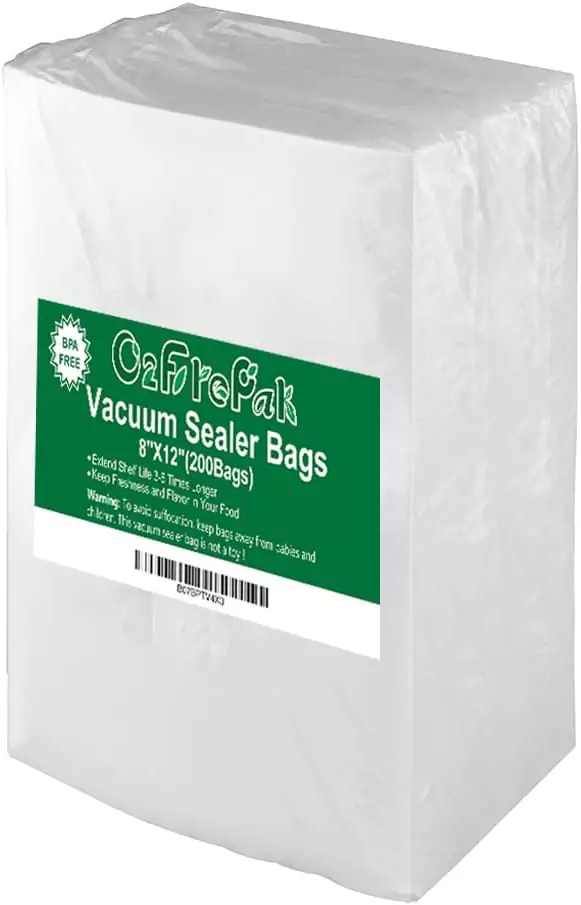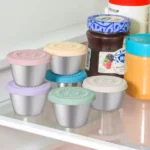We’ve all been there—opening the fridge only to find that last week’s groceries are already turning into science experiments. You probably think, “It’s not a big deal, I’ll just toss it.” But let’s be honest, all that wasted food adds up, doesn’t it?
Guess how much you’re throwing away—your money, time, and effort. You didn’t buy that fresh produce just to watch it rot, right?
Now, you could keep doing what you’ve always done and hope your food magically lasts longer. Or, you could take control of your kitchen and get serious about food storage. That’s where vacuum sealer bags come in.
These bags are like a secret weapon, keeping your food fresher for way longer and making freezer burn a thing of the past. If you’re tired of wasting food and cash, it’s time to give vacuum sealer bags a try.
Why Does Food Spoil So Fast?
Food spoils way faster than it should, right? You buy fresh produce, only to find it wilting in your fridge a few days later. Or maybe you throw that steak in the freezer, thinking it’s safe for a while, but when you pull it out, it’s covered in freezer burn and looks unappetizing. What’s going on?
The culprit here is oxygen. As soon as food is exposed to air, it starts to deteriorate. Oxygen triggers the growth of bacteria, mould, and other microorganisms that break food down, turning what was once fresh into something you wouldn’t dare eat. And it’s not just about the health risks—oxygen also speeds up moisture loss, leaving your food dried out and flavourless. That’s why your vegetables turn limp, your fruits get mushy, and your leftovers just don’t taste as good the next day.
Then there’s bacteria growth. Even in the refrigerator, bacteria thrive in oxygen-rich environments. Sure, the cold slows them down, but it doesn’t stop them entirely. That’s why even refrigerated food has a short shelf life.
Let’s not forget about freezer burn. You think your frozen food is safe, but freezer burn happens when the moisture in food evaporates, leaving behind dry, tough patches. It might not be harmful, but it ruins the texture and taste.
At the end of the day, all this leads to more food waste—which not only hits your wallet but also has a significant environmental impact. Every time we throw away spoiled food, we’re throwing away our money and contributing to a global food waste problem that’s bigger than most people realize.
How Vacuum Sealer Bags Work: The Science Behind Freshness
Ever wondered why some of your favourite foods seem to go bad way too quickly? It’s not just about the quality of the food; it’s about how you’re storing it. Let me break down the magic behind vacuum sealer bags and why they’re game-changers for keeping your food fresh.
Vacuum Sealing Technology
At its core, vacuum sealing is all about removing air. Think of it like giving your food a tight, cosy hug that locks in freshness. When you vacuum seal food, you’re using a special machine to suck out all the air from the bag. This process creates a vacuum-sealed environment that protects your food from the elements. Why does this matter? Because air—specifically oxygen—is a major player in food spoilage. It accelerates the growth of bacteria and mould, and it causes that dreaded freezer burn. By removing air, you’re effectively slowing down these spoilage processes and extending the life of your food.
How Removing Air Slows Down Spoilage
So, how does sucking out the air make such a big difference? Oxygen is the primary driver behind food decay. It reacts with fats and proteins, leading to oxidation, which makes food taste rancid and lose its nutritional value. Without oxygen, these chemical reactions slow down dramatically. It’s like putting your food in a time capsule where the ageing process is paused. This is why vacuum-sealed foods stay fresh longer, maintaining their taste, texture, and nutritional value.
Types of Food That Benefit Most from Vacuum Sealing
Not all foods are created equal when it comes to vacuum sealing, but many can benefit significantly. Here’s a quick rundown:
- Meat: Vacuum sealing is a game-changer for meats, whether it’s steaks, chicken, or ground beef. Removing air prevents freezer burn and keeps your meat tasting as fresh as the day you bought it. Plus, it’s great for bulk buying and meal prepping.
- Produce: Fruits and vegetables are notorious for spoiling quickly. Vacuum sealing helps them stay crisp and fresh for much longer. It’s especially useful for berries, leafy greens, and herbs that tend to wilt or rot fast.
- Dry Goods: Even pantry staples like pasta, grains, and nuts benefit from vacuum sealing. It keeps them fresh by preventing moisture from getting in, which can lead to mould and spoilage. You’ll find that your dry goods stay crunchy and flavorful for much longer.
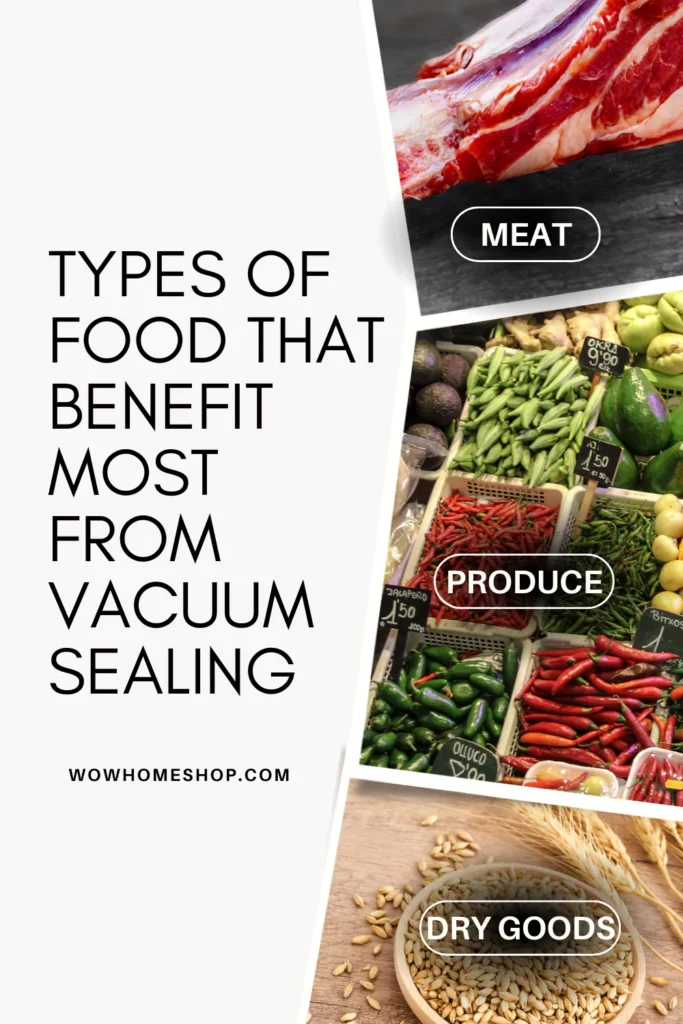

What Are the Advantages and Disadvantages of Vacuum Sealer Bags?
Advantages
- Extended Freshness: I’ve noticed that my food stays fresh up to five times longer with vacuum sealer bags. By removing air, these bags slow down the spoilage process and keep my meals tasting as good as the day I bought them.
- Prevents Freezer Burn: My frozen items no longer suffer from that unpleasant, freezer-burned taste. Vacuum sealing keeps moisture out, ensuring my meats and veggies stay intact.
- Saves Money: I’ve saved quite a bit by buying in bulk and preserving food effectively. The initial cost of the bags and sealer pays off by reducing food waste.
- Space Efficiency: With vacuum-sealed bags, my freezer and pantry are more organized. The bags flatten out, saving precious storage space.
Disadvantages
- Initial Cost: The upfront investment in a vacuum sealer and bags can be a bit steep. It’s something to consider if you’re on a tight budget.
- Learning Curve: There’s a bit of a learning curve in getting the sealing just right. It took me a few tries to master the technique.
- Not Ideal for All Foods: Some delicate items like bread can get squished in the sealing process. I’ve had to be careful with what I seal to avoid damage.
Top Most Reliable Vacuum Sealer Bags Brands on the Market
When it comes to choosing the best vacuum sealer bags for your kitchen, a few standout brands make a real difference in keeping your food fresh. Here’s a quick look at some top options:
Wevac Vacuum Sealer Bags offer a fantastic balance between durability and affordability. These bags are designed with a strong, multi-layer material that prevents punctures and tears, ensuring that your food stays sealed tight. Their ease of use with both clamp-style and suction-style sealers makes them versatile.
FoodSaver Precut Vacuum Sealer Bags are renowned for their convenience and reliability. These bags come in pre-cut sizes, eliminating the need for measuring and cutting. The unique channel design ensures maximum air removal, making them perfect for preserving meats, vegetables, and even soups.
Syntus Vacuum Sealer Bags stand out with their eco-friendly approach. Made from BPA-free materials, these bags are safe for food and the environment. Their heavy-duty construction prevents freezer burn and spoilage, and they’re compatible with most vacuum sealers.
Bonsenkitchen Vacuum Food Sealer Bags are known for their affordability and effectiveness. These bags feature a textured surface for optimal vacuum sealing and are great for both wet and dry foods. They’re a practical choice for those looking to save without sacrificing quality.
O2frepak Vacuum Sealer Bags offer a premium option with their heavy-duty, puncture-resistant material. These bags are perfect for those who need extra protection for long-term storage. Their enhanced seal technology ensures your food stays fresh, even in demanding conditions.
Read More
What are the Right Vacuum Sealer Bags for Your Needs?
When it comes to preserving your food with vacuum sealer bags, you’ve got choices—and each one has its own set of perks. Let me walk you through what you need to know to make the best decision for your kitchen.
Vacuum Sealer Rolls and Pre-Cut Bags
Vacuum sealer rolls are super versatile. You can cut them to any length you need, which means you’re not stuck with one-size-fits-all bags. They’re perfect for odd-shaped items or when you want to customize the size of your bags. On the other hand, pre-cut bags are convenient and ready to use. If you’re the type who likes to keep things simple, these are a great choice. Just grab a bag, seal it, and you’re done!
Reusable vs. Disposable
Reusable bags are fantastic if you’re all about sustainability and saving money in the long run. You can wash them and use them over and over, which makes them a more eco-friendly option. However, if you prefer convenience and don’t mind a bit of extra waste, disposable bags might suit you better. They’re especially handy for quick, one-time use or when you’re sealing up a bunch of different foods in one go.
Bag Thickness
It might seem like a small detail, but it’s actually pretty important. Thicker bags are generally more durable and better at preventing freezer burn. They offer extra protection for your food, especially if you’re storing items in the freezer. If you’re dealing with heavy-duty items like meats or cheeses, thicker bags are a must. For lighter or less delicate items, you might get away with thinner bags, but keep in mind that they won’t offer the same level of protection.
How to Use Vacuum Sealer Bags Effectively
So, you’ve decided to give vacuum sealer bags a try, and you’re ready to take control of your food storage. I’m here to walk you through how to use these bags effectively to ensure you get the best results every time. Let’s dive into the step-by-step guide and some pro tips that will make your vacuum sealing experience a breeze.
How to Use Vacuum Sealer Bags Effectively
So, you’ve decided to give vacuum sealer bags a try, and you’re ready to take control of your food storage. I’m here to walk you through how to use these bags effectively to ensure you get the best results every time. Let’s dive into the step-by-step guide and some pro tips that will make your vacuum sealing experience a breeze.
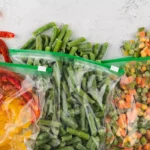

Step-by-Step Guide to Using Vacuum Sealer Bags


Before you start sealing, think about how you use your food. Portion it into meal-sized amounts. This way, you avoid defrosting more than you need and reduce waste. For example, if you’re sealing meat, divide it into individual servings.
If you’re sealing something hot or warm, let it cool to room temperature first. Placing hot food in a vacuum sealer bag can create steam and mess with the sealing process.
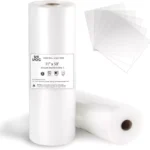

Choose the appropriate size of vacuum sealer bags for your portion. If you’re sealing large items or bulk quantities, use rolls to create custom-sized bags. For smaller portions, pre-cut bags are convenient.


Place your food in the bag, leaving enough space at the top for the vacuum sealer to create a proper seal. A good rule of thumb is to leave about 2-3 inches of space from the top of the bag.
Insert the bag into the vacuum sealer, making sure the opening is properly aligned with the machine’s sealing strip.
Close the sealer lid and initiate the vacuum process. The machine will suck out the air and seal the bag automatically. Ensure there are no wrinkles in the bag along the sealing strip; wrinkles can cause leaks and spoilage.
Tips for Best Results
- Portioning Food: Think about how you use your ingredients. Portioning food into meal-sized amounts or single servings helps you only defrost what you need and keeps the rest fresh. It’s also great for batch cooking!
- Labelling: Don’t forget to label and date your bags before sealing. It’s easy to forget what’s inside, especially when you’re stacking them in the freezer. A simple label with the date and contents will save you a lot of guessing later.
- Proper Sealing Techniques: Ensure the bag’s opening is completely clean and free of food particles before sealing. Any residue can interfere with the sealing process and cause the bag to leak. For extra precaution, use a damp cloth to wipe the top edge of the bag before sealing.
- Vacuuming Wet Foods: If you’re sealing wet or juicy foods, consider using a bag with a built-in mesh layer or a special moisture-proof bag. This helps prevent liquid from interfering with the vacuum process and ensures a tight seal.
Can Vacuum Sealer Bags Really Save You Money?
Certainly, please remember that Vacuum sealer bags offer the potential to significantly impact food preservation practices. While their initial cost may appear steep, the long-term savings they yield more than justify the investment. Consider the broader implications: the use of these bags not only preserves food but also minimizes food wastage.
Every time you vacuum-seal meat or produce, you’re extending its shelf life significantly. No more tossing out half-used packs of meat or mouldy veggies. That’s money saved right there! Imagine saving those items from spoiling too soon—you’re getting more bang for your buck from every grocery trip.
Plus, buying in bulk becomes less of a gamble. You can stock up on staples and freeze them, knowing they’ll be fresh when you need them. The savings on buying in bulk vs. buying smaller amounts regularly can add up over time. So, while you might spend a bit more upfront, the money you save by avoiding food waste and buying in bulk makes vacuum sealer bags a smart investment for your budget.
Wrapping Up
If you’re tired of tossing out food that’s gone bad too soon, vacuum sealer bags are a game changer. They not only extend the shelf life of your food but also prevent freezer burn and help you save money by reducing waste. Plus, they make managing your pantry and freezer a breeze.
So why wait? Try out vacuum sealer bags today and see for yourself how easy it is to keep your food fresh and your wallet happy!
